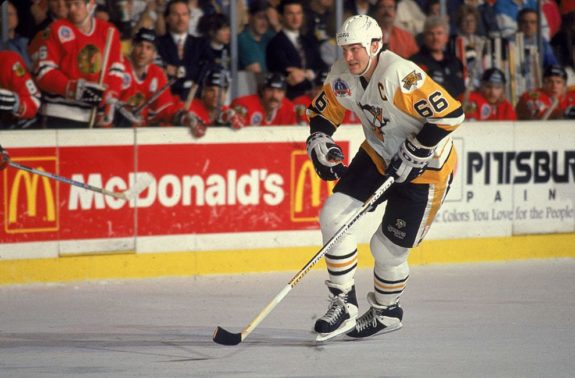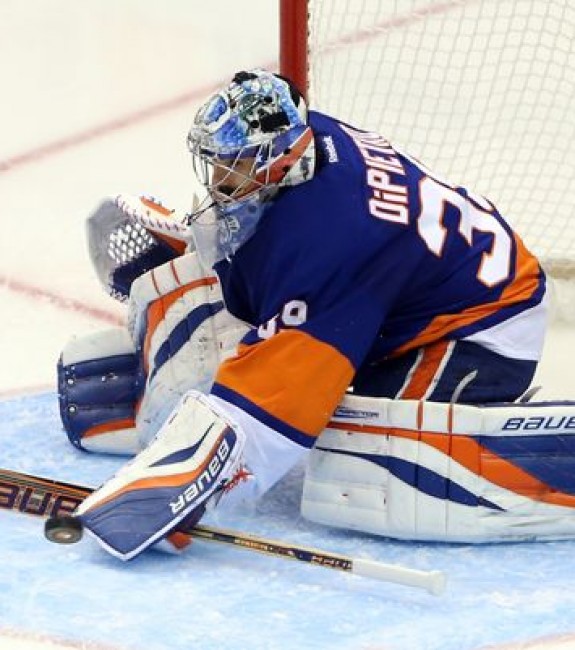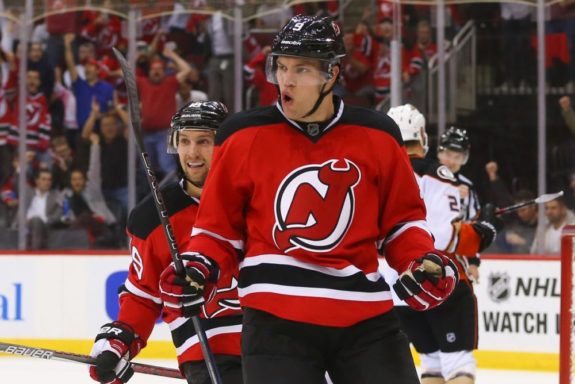Young players strive to be the best at their craft – no matter the sport. For some, it pays off and they’re scouted as prospects for the game’s next generation. While expectations are significantly high for any player taken in the first round of the NHL Draft, they’re exponentially higher for those taken first overall.
Some, like Joe Thornton, thrive off the expectations and turn in Hall-of-Fame-type careers, while others like Patrik Stefan never seem to find their footing and are forever labelled busts by the hockey world.
With that in mind, what are the odds of first overall picks finding success at the NHL level?
1st Overall Picks: Creating a Career Average Baseline
The NHL Amateur Draft ran from 1963 to 1978. For reason of focusing in on the modern day NHL Entry Draft, we’ve excluded first overall picks from the 16 Amateur Drafts and instead will be discussing the number one picks from 1979 when the Colorado Rockies drafted Rob Ramage to 2017 and the Devils picking Nico Hischier.

From the 39 players drafted first overall since 1979, two of them are goaltenders and we’ll be talking about them separately from the skaters. Of the 37 skaters, 21 of them are retired from the NHL with one goaltender also having ended his NHL career.
The other 16 skaters are still active in the NHL with one goaltender also playing prominent role in the league today.
The retired players were separated from the active players in averaging out their career numbers and average seasons. With that said, here’s how it all broke down.
Retired Players
Of the 21 skaters drafted first overall since 1979 who’ve retired from the NHL, 18 played in 500-plus games. Ten of them played more than 1,000 regular season games, with the Mike Modano having played the most at 1,499 over his career.
In terms of offensive statistics, the numbers are quite compelling. Ten players notched 300-plus goals in their careers, while eight tallied over 400 and five notched more than 500. Mario Lemieux topped that list with 690 goals while having played less than 1,000 regular season games in the NHL.

When it came to points, 14 of the 21 notched 500-plus, only four player hit the 1,000-point plateau, while Lemieux was the only player drafted first overall to top the 1,500-point mark.
The average career length for these players was 14.5 seasons and here’s how the average career looked.
| Average Career Length (21 retired skaters) | Games Played | Goals | Assists | Points |
| 14.5 seasons | 932 | 289 | 439 | 728 |
Consider that the baseline. Now, we put together a list of these players who would qualify as all-stars of the group. These players qualified for the list in one of two ways – either they played over 1,000 career games which proved longevity or they averaged more than a point-per-game over their respective careers.
Of the 21 players, 13 qualified as all-stars – Rob Ramage, Dale Hawerchuk, Lemieux, Pierre Turgeon, Mike Modano, Mats Sundin, Owen Nolan, Eric Lindros, Roman Hamrlik, Ed Jovanovski, Chris Phillips, Vincent Lecavalier, and Ilya Kovalchuk.
The all-stars averaged 220 more games than the average first overall pick, nearly 100 more goals and just over 250 more points than our average baseline.
| Average All-Star Career Length (13 retired skaters) | Games Played | Goals | Assists | Points |
| 17 seasons | 1,152 | 383 | 593 | 976 |
Remember that this also took into account Lemieux and Lindros whose careers were cut short, while Kovalchuk also left the NHL prematurely. Based on those numbers alone, there would be a 62 percent chance that a team would draft an all-star quality player with the first overall pick.
But, there are still more numbers to file through.
Active Players
Right now, there are 16 players drafted first overall since 1979 who are still playing in the league. Some of them are just starting out, while others (like Thornton) are the grizzled veterans of their respective teams.
Thus far, including Thornton’s 20 seasons and Hischier’s half of a season, the active players average eight and a half seasons at the NHL level. For the most part, their numbers are well on their way to joining the all-star list of retired first overall picks.
Based on their averages, here’s an average baseline for active first overall picks.
| Average Career Length (16 active skaters) | Games Played | Goals | Assists | Points |
| 8.5 seasons | 575 | 211 | 301 | 512 |
That’s a point-per-game average of 0.89 – certainly a respectable mark for any NHL player. While it’s tougher to define the careers of defensemen based on offensive numbers, we can assume that a player like Ekblad has lived up to expectations at this point. But it’s still early.
That said, the only two players that really haven’t found their way entirely are Edmonton’s Ryan Nugent-Hopkins and former Oiler Nail Yakupov. For others, like Hischier and Matthews, it’s still far too early, but the signs are pointing in the right direction for both.

Assuming Yakupov, Nugent-Hopkins and Erik Johnson are the only three that haven’t lived up to the hype of being drafted first overall, that means 81 percent of the active first overall players would qualify as all-star quality skaters.
Single Season Baselines: Average vs. All-Star
For retired players, it was easier to get a read for what an average season would be based on the numbers. Again, we took all 21 and averaged out their careers to find a baseline for the entire class of retired players. Here’s what it looked like.
| Average Season (21 retired skaters) | Games Played | Goals | Assists | Points |
| 64 | 20 | 30 | 50 (64 points in an 82-game season) |
That’s an average of 0.78 points-per-game and includes the careers of busts like Alexandre Daigle and Stefan. So, once again, we took the 13 players who had all-star like seasons. Based on their numbers, their careers lasted two and half years longer on average and their average season looked just slightly better (defensemen obviously brought down the average offensive numbers).
| Average All-Star Season (13 retired skaters) | Games Played | Goals | Assists | Points |
| 68 | 23 | 35 | 58 (70 points in an 82-game season) |
That works out to an average of 0.85 points per game – a slight increase over the average first overall pick.
For active players, the average season actually ended up much higher. While they still averaged 68 games played per season, their point-per-game average increased even more than that of the all-star quality players (to 0.90 points per game).
| Average Season (16 active skaters) | Games Played | Goals | Assists | Points |
| 68 | 25 | 36 | 61 (74 points in an 82-game season) |
Obviously if defensemen weren’t included, those numbers would be increasingly higher. But blueliners have been known to slide in as first overall picks from time to time. Just as goaltenders have done so – twice in the last 39 years to be exact.
Looking Between the Pipes
As for goaltenders, there have only been two drafted first overall in the last 39 years. The New York Islanders took the injury-plagued Rick DiPietro in 2000, while the Penguins grabbed Marc-Andre Fleury with the top pick in 2003.

While Fleury remains in the league, we decided to average out their career numbers and create an average season baseline and a career baseline. As you’ll see, DiPietro ended his career as a below average goaltender in this case while Fleury continues to exceed – or simply live up to – expectations.
With that in mind, here’s how the career averages broke down.
| Average Career Length (2 goaltenders) | Games Played | Record | Goals Against | GAA | Shots Against | Sv% | Shutouts |
| 12.5 seasons | 512 | 257-178-53 | 1,305 | 2.55 | 14,437 | 0.910 | 31 |
In the case of the injury-riddled career that was DiPietro’s, he finished worse in all categories. For starters, he only played parts of 11 seasons. He had a losing record of 130-136-36 (a point percentage of 0.490), finishing with a .902 save percentage, a 2.87 career goals against average and 16 shutouts. I’d consider that a below average goaltender.
On the other hand, Fleury has played in 705 regular season games with a record of 384-219-70 (a point percentage of 0.623). He has a .913 save percentage and 2.57 goals against average with 46 shutouts over 14 seasons in the NHL.

So while it’s hard to judge the level of success based on just two goalies, it’s pretty clear that one has had a much better career than the other.
It is often said that goaltenders take longer to develop, so it can be risky taking one with the first overall pick in the draft. That said, chances of drafting a successful NHL goaltender first overall seems to be split based on these numbers.
What Are the Odds?
Based on the average seasons, it’s 50-50 that you’re going to find a successful goaltender at the top of the draft. For skaters, it seems that you’re looking at better odds.
Assuming that 0.89 points per game makes for a quantifiably successful season, the odds are in the favour of teams picking at the top spot. To further that, longevity is also valued in the NHL, so players having played 1,000-plus games have usually stuck around for a fair amount of time and added something to the league and their respective teams.
With that in mind, the last 39 years have really put a lot of value in the first overall pick. Seven players have reached the 1,000-game mark without hitting the 0.89 point-per-game average, six others hit the 1,000-game plateau and scored at a higher rate than 0.89, while nine others have played less than 1,000 games but have a career point-per-game average higher than 0.89. That excludes guys like Hischier, Nathan MacKinnon, Taylor Hall and Aaron Ekblad.

With those number alone (and adding Fleury to the mix), you have 23 of the last 39 first overall picks would be considered successful NHL players. That’s nearly 60 percent. Now assuming you think that Hischier, Ekblad, MacKinnon and Hall are also considered successful so far in their careers, that’s 27 of the 39 players – or nearly 70 percent of first overall picks.
While there are far too many parameters to measure a successful NHL player – position, type of player, era in which he played, etc. – one thing is for sure. The majority of top picks do work out at the NHL level – and teams with the top pick should consider themselves lucky to be in that position.